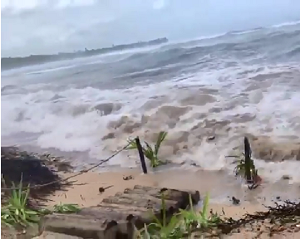
The entrance of the equinox (22-23 September) produced the slight inclination of the Earth that together with global warming and the cyclonic season and combined this year to produce abnormal swells in diverse coastal points of the country.
According to Omar Ramírez, former director of the National Council for Climate Change, these natural and climatic conditions explain the waves that rushed inwards in Playa Macao and Uvero Alto in La Altagracia province and other localities.
“In each season and we are entering autumn, the Earth changes 15 degrees in its axis; these movements cause abnormal swells. These are the first autumn and winter tides that occur naturally,” Ramírez told N Digital.
He also reported that September was one of the hottest months on the planet, affecting the atmosphere and therefore the hydrosphere, altering the waves.
The high swells were also felt in Sosúa, Puerto Plata in the north coast. And there was out of the usual flooding over streets and main road in southwestern Barahona city and abnormal waves on beaches of San Rafael and Los Patos in Barahona province. In the Sierra de Bahoruco, also in the southwest, large pools of water were reported on the road to Hoyo de Pelempito. In Constanza, in the central mountain range, the Cordillera Central, the flooding of las Auyamas River was reported.
The equinoxes are the times of the year when the sun is on the plane of the celestial equator. On that day and for an observer on the Earth’s equator, the sun reaches the zenith (the highest point in the sky in relation to the observer, who is just above his head, i.e. at 90°).
The phenomenon occurs twice a year: between 19 and 21 March and between 21 and 24 September each year. On the dates when equinoxes occur, the day has a duration roughly equal to that of the night in all parts of planet Earth.
Read more in Spanish:
N Digital
25 September 2019

